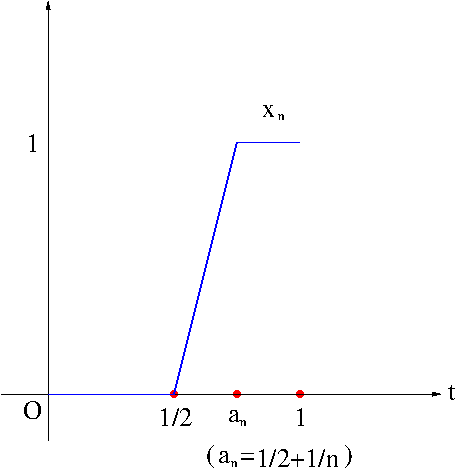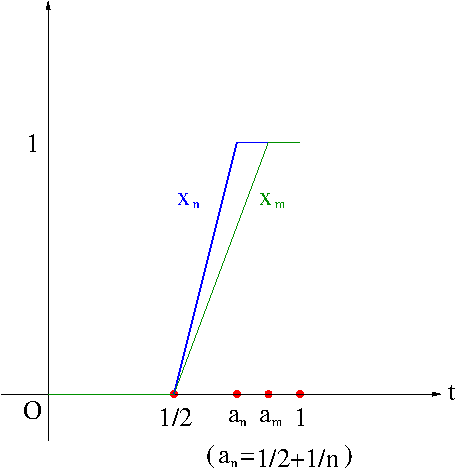Definition. Let $X$ be a vector space. A linear functional is a linear map $f:\mathcal{D}(f)\subset X\longrightarrow\mathbb{R}$ (or $f:\mathcal{D}(f)\subset X\longrightarrow\mathbb{C}$).
Definition. A linear functional $f:\mathcal{D}(f)\longrightarrow\mathbb{R}$ is said to be bounded if there exists a number $c$ such that $|f(x)|\leq c||x||$ for all $x\in\mathcal{D}(f)$. Just as in linear operators case $||f||$ is defined by
\begin{align*}
||f||&=\sup_{\begin{array}{c}x\in\mathcal{D}(f)\\x\ne O\end{array}}\frac{|f(x)|}{||x||}\\
&=\sup_{\begin{array}{c}x\in\mathcal{D}(f)\\||x||=1\end{array}}|f(x)|.
\end{align*}
Also we have the inequality holds
$$|f(x)|\leq ||f||||x||$$
for all $x\in\mathcal{D}(f)$.
Just as in linear operators case, we have the following theorem holds.
Theorem. A linear functional $f$ with domain $\mathcal{D}(f)$ in a normed space is continuous if and only if $f$ is bounded.
Example. Let $a=(\alpha_j)\in\mathbb{R}^3$. Define $f:\mathbb{R}^3\longrightarrow\mathbb{R}$ by
$$f(x)=x\cdot a=\xi_1\alpha_1+\xi_2\alpha_2+\xi_3\alpha_3$$ for each $x=(\xi_j)\in\mathbb{R}^3$. Then $f$ is a linear functional. By Cauchy-Schwarz inequality, we obtain
$$|f(x)|=|x\cdot a|\leq ||x||||a||$$
which implies $||f||\leq ||a||$. On the other hand, for $x=a$
$$||a||=\frac{||a||^2}{||a||}=\frac{|f(a)|}{||a||}\leq ||f||.$$
Hence, we have $||f||=||a||$.
Example. Define $f:\mathcal{C}[a,b]\longrightarrow\mathbb{R}$ by
$$f(x)=\int_a^b x(t)dt$$
for each $x(t)\in\mathcal{C}[a,b]$. Then $f$ is a linear functional.
\begin{align*}
|f(x)|&\leq\left|\int_a^b x(t)dt\right|\\
&\leq(b-a)\max|x(t)|\\
&=(b-a)||x||.
\end{align*}
So, $||f||\leq b-a$. Let $x=x_0=1$. Then
\begin{align*}
b-a&=\int_a^b dt\\
&=\frac{|f(x_0)|}{||x_0||}\\
&\leq ||f||.
\end{align*}
Hence, we have $||f||=b-a$.
Let $X^\ast$ be the set of all linear functionals. Then $X\ast$ can be made into a vector space. For any $f,g\in X^\ast$ and scalar $\alpha$, define addition $f+g$ and scalar multiplication $\alpha f$ as follows: For each $x\in X$,
\begin{align*}
(f+g)(x)&=f(x)+g(x),\\
(\alpha f)(x)&=\alpha f(x).
\end{align*}
$X^\ast$ is called the dual space of $X$. One may also consider $X^{\ast\ast}=(X^\ast)^\ast$, the dual space of $X^\ast$. Fix $x\in X$. Define a map $g_x: X^\ast\longrightarrow\mathbb{R}$ by
$$g_x(f)=f(x)$$
for each $f\in X^\ast$. For any $f_1,f_2\in X^\ast$,
\begin{align*}
f_1=f_2&\Longrightarrow f_1(x)=f_2(x)\\
&\Longrightarrow g_x(f_1)=g_x(f_2).
\end{align*}
so, $g_x$ is well-defined. Furthermore, $g_x$ is linear. To show this, for any $f_1,f_2\in X^\ast$ and scalars $\alpha,\beta$,
\begin{align*}
g_x(\alpha f_1+\beta f_2)&=(\alpha f_1+\beta f_2)(x)\\
&=\alpha f_1(x)+\beta f_2(x)\\
&=\alpha g_x(f_1)+\beta g_x(f_2).
\end{align*}
Define a map $C: X\longrightarrow X^{\ast\ast}$ by
$$Cx=g_x$$
for each $x\in X$. Then $C$ is a linear map. First let $x=y\in X$. Then for any $f\in X^\ast$, $g_x(f)=f(x)=f(y)=g_y(f)$, so $C(x)=g_x=g_y=C(y)$. Hence, $C$ is well-defined. To show that $C$ is linear, let $x,y\in X$ and $\alpha,\beta$ scalars. For any $f\in X^\ast$,
\begin{align*}
g_{\alpha x+\beta y}(f)&=f(\alpha x+\beta y)\\
&=\alpha f(x)+\beta f(y)\ (f\ \mbox{is linear})\\
&=\alpha g_x(f)+\beta g_y(f)\\
&=(\alpha g_x+\beta g_y)(f).
\end{align*}
Thus,
$$C(\alpha x+\beta y)=g_{\alpha x+\beta y}=\alpha g_x+\beta g_y=\alpha Cx+\beta Cy.$$
If $X$ is an inner product space or $X$ is a finite dimensional vector space, $C$ becomes oen-to-one. Let us assume that $X$ is equipped with an inner product $\langle\ ,\ \rangle$. Then for any fixed $a\in X$, the map $f_a: X\longrightarrow\mathbb{R}$ defined by
$$f_a(x)=\langle a,x\rangle\ \mbox{for each}\ x\in X$$
is a linear functional. Let $Cx=Cy$. Then $g_{x-y}=0$ and so $g_{x-y}(f_{x-y})=||x-y||^2=0$, hence $x=y$. Therefore, $C$ is one-to-one. We will discussed the case when $X$ is finite dimensional in the next lecture. If $C$ is one-to-one, $X$ is embedded into $X^{\ast\ast}$. We call $C:X\hookrightarrow X^{\ast\ast}$ the canonical embedding. (Here, the notation $\hookrightarrow$ means an embedding or a monomorphism.) If in addition $C$ is onto i.e. $X\stackrel{C}{\cong}X^{\ast\ast}$, then $X$ is said to be algebraically reflexive. If $X$ is finite dimensional, then $X$ is algebraically reflexive. This will be discussed in the next lecture as well.


